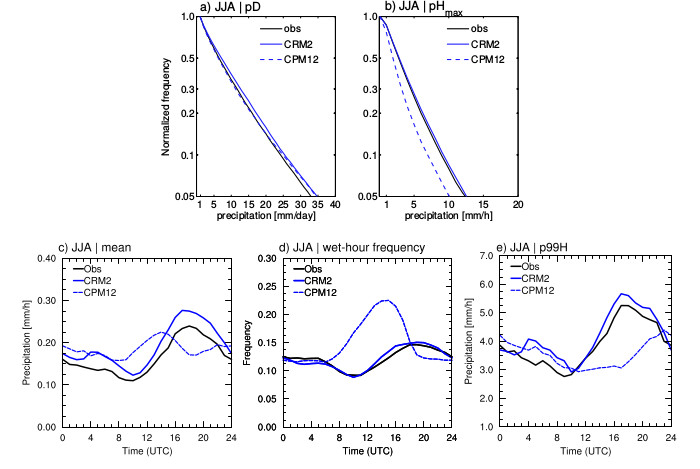Dynamical Downscaling at Kilometer-Scale Resolution
To better understand and represent small-scale processes and physical feedbacks that are relevant for weather and climate, we conduct real-case and idealized high-resolution simulations at a horizontal resolution O(100 m-10 km) that include an explicit (rather than parameterized) treatment of moist convection and a better representation of the topography and the underlying surface. The research addresses climate-scale simulations (up to 10 years) as well as case and process studies. Results demonstrate improvements over lower-resolution simulations, for example, in terms of the diurnal cycle of precipitation or the frequency-intensity distributions for hourly precipitation (Hohenegger et al., 2008, Ban et al., 2014, Leutwyler et al., 2017)

Our group is leading a major modeling project entitled "Convection-Resolving Climate Modeling on Future Supercomputing Platforms" (crCLIM) which is funded by the Swiss National Science Foundation through the Sinergia program. The crCLIM project aims to develop a European-scale convection-resolving climate modeling capability at a horizontal resolution of about 2 km using the next generation of supercomputing platforms. Our group performs, validates and analyzes convection-resolving climate changes simulations over Europe (Leutwyler et al., 2016, 2017).

The Latsis symposium 2019 has been held in ETH-Zurich during August 21st-23rd with the aim to join the computer science and high-resolution modelling communities to tackle some of the biggest challenges faced nowadays in climate science. The event was fully successful, with more than 100 people attending for sharing their knowledge and research to a large international audience of scientists.
ETH news (05.2018): A study of a team of MeteoSwiss, ETH and C2SM researchers, led by Dr. Oliver Fuhrer, investigated how close we are towards achieving global km-scale weather and climate simulations. A baseline of what is achievable today is established using a fully refactored model code on Europe’s largest supercomputer Piz Daint at the Swiss National Supercomputing Centre CSCS in Lugano.
external pageThe Platform for Advanced Scientific Computing (PASC) Conferencecall_made (06.2017): Christoph Schär (ETH Zurich, Switzerland) gave a lecture on 'external pageHow to Escape from the Data Avalanche of High Resoultion Climate Modelscall_made'.
external pageAGU’s Earth & Space Science Newscall_made (06.2017): For the first time, a decade-long convection-resolving climate simulation has been conducted for continental-scale computation domain located over Europe. The results show the robustness of the improvements in the representation of summer convection, and demonstrate that convection-resolving climate simulations on a continental-scale computational domain are feasible. Exploiting the capabilities of new supercomputers that mix conventional multi-core CPUs and accelerators contains the computational costs while providing a reasonable time to solution.
Fuhrer, O., Chadha, T., Hoefler, T., Kwasniewski, G., Lapillonne, X., Leutwyler, D., ... & Vogt, H. (2018). Near-global climate simulation at 1 km resolution: establishing a performance baseline on 4888 GPUs with COSMO 5.0. Geoscientific Model Development, 11(4), 1665-1681, external pagehttps://doi.org/10.5194/gmd-11-1665-2018call_made
Leutwyler, D., D. Lüthi, N. Ban, O. Fuhrer, and C. Schär (2017), Evaluation of the convection‐resolving climate modeling approach on continental scales, J. Geophys. Res. Atmos., 122, 5237–5258, external pagehttps://doi.org/10.1002/2016JD026013call_made.
Leutwyler, D., Fuhrer, O., Lapillonne, X., Lüthi, D., and Schär, C.: Towards European-scale convection-resolving climate simulations with GPUs: a study with COSMO 4.19, Geosci. Model Dev., 9, 3393-3412, external pagehttps://doi.org/10.5194/gmd-9-3393-2016call_made, 2016.
Ban, N., J. Schmidli, and C. Schär (2014), Evaluation of the convection-resolving regional climate modeling approach in decade-long simulations, J. Geophys. Res. Atmos., 119, 7889–7907, external pagehttps://doi.org/10.1002/2014JD021478call_made
Leutwyler, D., O. Fuhrer, X. Lapillonne, D. Lüthi, C. Schär (2015): Continental-Scale Climate Simulation at Kilometer-Resolution. ETH Zurich e-collection, external pagehttp://dx.doi.org/10.3929/ethz-a-010483656call_made (short description and animation), online video on Vimeo.
